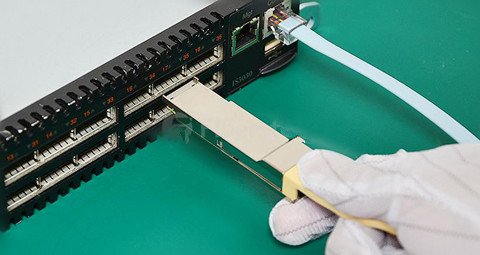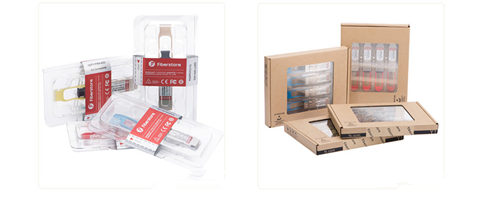The Ethernet standard relied on duplex fiber cabling with each channel using one fiber to transmit and the other to receive. But for the 802.3ab standard, parallel optics are required to transmit and receive signals. For instance, there are eight fibers associated with the channel—four for Tx signal and four for Rx signal, each transmitting at 10Gbqs for an aggregate bandwidth of 40Gbqs. For 40G interconnection infrastructure, there are 40GBASE-SR4, 40GBASE-CSR4 and 40GBASE-ESR4 QSFP+ transceivers. Today’s article will highlight some practical solutions to the cabling connectivity for 40G short-reach transceivers.

40G Short-Reach Transceivers
As noted before, 40G optical transceivers typically use four 10G channels to transmit and four 10G channels to receive over one 12-fiber assembly providing 40Gbqs bandwidth, the middle four fibers remain unused, or dark. Each fiber either transmits (Tx) or receives (Rx) 10G traffic at a single wavelength. Compared with other 40G transceivers, 40G QSFP+ transceiver wins the largest market share for 40 Gigabit Ethernet applications as a result of its smaller size and high performance. 40GBASE-SR4 optics solution for multimode fiber was released by IEEE standard 802.3ba in 2010. Since then, some other engineered solutions have been released, including 40GBASE-CSR4 and 40GBASE-ESR4, which are similar to 40GBASE-SR4 but extends the distance capabilities. Here is what you need to know about these 40G optics.
- 40GBASE-SR4 QSFP
40GBASE-SR4 QSFP+ modules primarily enable high-bandwidth 40G optical links over 12-fiber parallel fiber terminated with MPO/MTP multi-fiber female connectors. It can support link lengths of 100 meters and 150 meters over laser-optimized OM3 and OM4 multimode fibers respectively. Take 720187-B21 as an example, it is HP 40GBASE-SR4 QSFP+ that can be used to connect with four 10GBASE-SR optical interfaces using an 8-fiber MTP to 4 duplex LC cable. Note that 720187-B21 from Fiberstore is much lower than ebay or Amazon. The following image shows the package options of Fiberstore.

- 40GBASE-CSR4 QSFP
40GBASE-CSR4 QSFP+ modules can be used for native 40G optical links over 12-fiber parallel cables with MPO/MTP female connectors or in a 4x10G mode with parallel to duplex fiber breakout cables for connectivity to four 10GBASE-SR interfaces. It can extend the reach of 40GBASE-SR4 interface to 300 and 400 meters over laser-optimized OM3 and OM4 multimode parallel fibers.
- 40GBASE-ESR4 QSFP
The QSFP+ 40GBASE-ESR4 module provides 40 Gbps optical Ethernet connectivity for up to 300 meters using OM3 or up to 400 meters over OM4 cable. This 40 Gigabit Ethernet transceiver module provides excellent performance in port-dense networks with challenging thermal environments. It also has the capability to breakout into four MMF cables with LC duplex connectors. The 40GBASE-ESR4 is compliant with 40GbE IEEE 802.3ba-2010 (40GBASE-SR4) specifications and per channel basis to the IEEE 802.3ae 10GBASE-SR optical specification. For example, Juniper QFX-QSFP-40G-ESR4 is a high-performance and cost-effective 40GBASE-ESR4 QSFP+ transceiver designed for 40GbE applications.
Cabling Solutions for 40GBASE-SR4 QSFP+ Transceivers
To connect a 40G parallel transceiver to another 40 Gigabit Ethernet transceiver, a Type-B female MPO/MTP to female MPO/MTP cable is required. The following figure shows two QSFP+ transceivers being connected with an MTP female cable. The fiber position is reverse on the ends of the assembly. This reverse fiber positing allows the signal to flow from transmission on one end of the link to reception on the other end. This type of direct connectivity is only suggested for short distances within a given row of racks/cabinets. It has less robustness (less tensile strength, less crush and impact resistance, etc.) than a distribution-style cable, which would be used for structured cabling trunks.

In addition, there are some other cabling solutions for parallel optics 40G connectivity. First, in the interconnect structured cabling system, MTP Trunk cables will be deployed by placing them in cable trays without the fear of the trunk cable being crushed. Second, with 2×12 to 3×8 or 1×24 to 3×8 harness assembly, 100% fiber utilization will save the cost of fiber utilization in the structure cabling. And it also saves the cost of deploying labor and materials. Make sure that each MTP connector is plugged into a port. Last but not least, this approach uses 40G channel interconnect structured with conversion devices: 2×3&1×3 modules. It can utilize 100% of the installed fiber as harnesses. It is easily accomplished by using Type-B non-pinned MTP to non-pinned MTP jumpers.
Conclusion
There is no doubt that 40G era is coming, 40GBASE-SR4 QSFP+ transceivers support with a link length up to 100 meters on OM3 and 150m on OM4 enabling high-bandwidth 40G optical links over 12-fiber parallel fiber terminated with MPO/MTP multi-fiber female connectors, which is the ideal solution for migration to 40G Ethernet. FS.COM offers a wide range options of brand-compatible 40GBASE-SR4 QSFP+ transceivers. In order to ensure each transceiver with high compatibility, we have a reliable test-assured program for each optics. The above 720187-B21 and QFX-QSFP-40G-ESR4 are also provided.
评论
发表评论